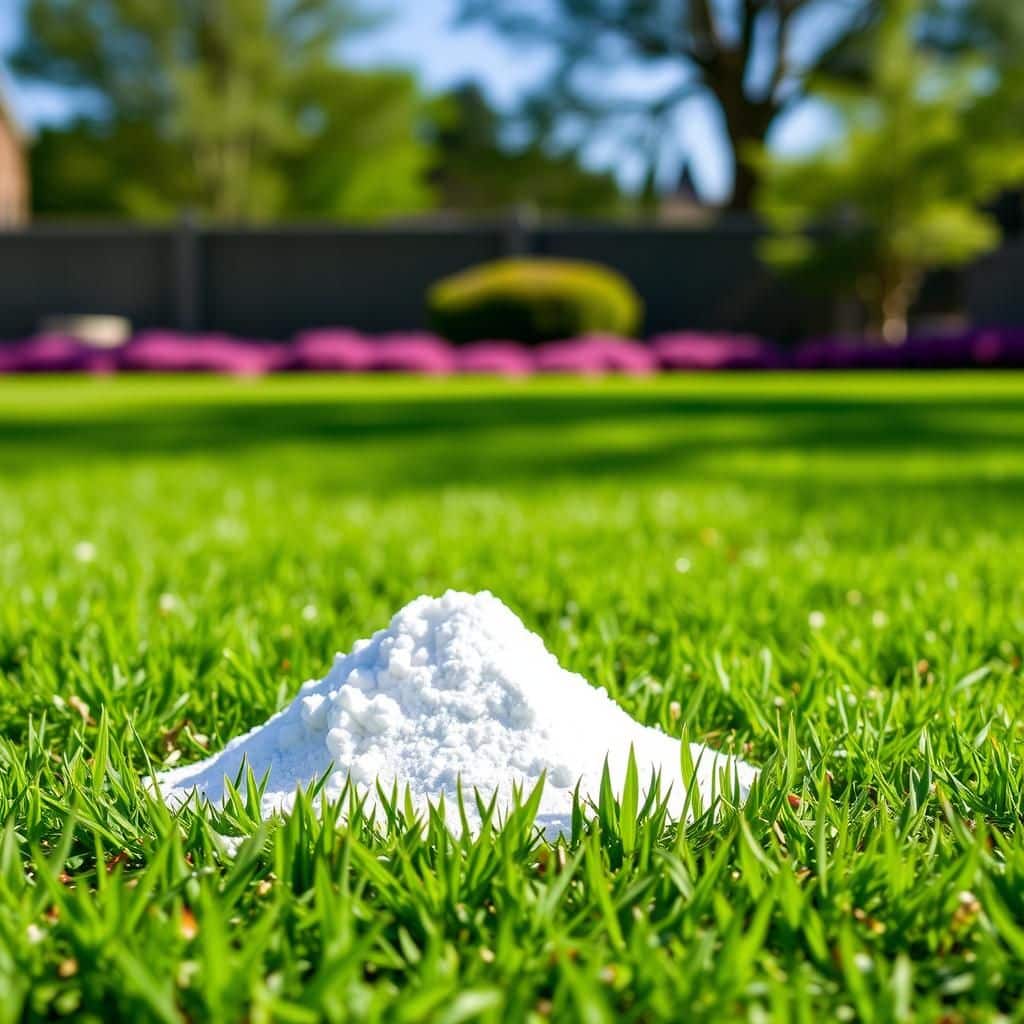Should I Put Gypsum on My Lawn? A Complete Guide to Lawn Health and Care

Maintaining a healthy lawn requires a careful balance of nutrients, soil structure, and moisture levels. One common amendment that often comes into question is gypsum. But should you put gypsum on your lawn? This complete guide will explore the benefits and considerations of using gypsum in lawn care. From understanding its role in improving soil drainage to its potential in correcting nutrient imbalances, we will cover everything you need to know about incorporating gypsum into your lawn maintenance routine. Whether you’re looking to enhance grass growth or address specific soil issues, this guide will provide valuable insights for achieving a thriving lawn.
Should I Put Gypsum on My Lawn?
Adding gypsum to your lawn can provide several benefits, particularly if you’re dealing with heavy clay soils or issues related to salinity and compaction. Gypsum, a naturally occurring mineral composed primarily of calcium sulfate, works by improving soil structure, enhancing drainage, and promoting better root growth. It's also beneficial in reducing soil compaction, which can hinder the absorption of nutrients and water, ensuring that your lawn thrives with increased fertility. Additionally, gypsum can help in the leaching of harmful sodium from the soil, thus improving its overall quality. However, it's essential to assess your specific soil conditions and consult with a local extension service or professional before applying gypsum to ensure it's right for your lawn's requirements.
What is Gypsum?
Gypsum is a soft sulfate mineral composed of calcium sulfate dihydrate. It is widely used in agriculture as a soil amendment due to its ability to improve soil structure and reduce compaction. By adding calcium, it facilitates the separation of soil particles, which enhances water infiltration and promotes deeper root development. Gypsum does not alter the soil pH, making it an effective choice for those looking to improve soil quality without affecting the soil's acidity or alkalinity.
Benefits of Using Gypsum
The primary benefits of using gypsum on your lawn include improving soil structure, enhancing drainage, and promoting better nutrient absorption. This improvement leads to healthier grass and increased drought resistance. Gypsum also helps to ameliorate salinity in soils, making it easier for plants to take up water and nutrients. Furthermore, it aids in reducing runoff and erosion, making it an environmentally friendly option for lawn care.
How to Apply Gypsum
Applying gypsum to your lawn typically involves spreading it evenly across the surface. It's recommended to use about 40 pounds of gypsum per 1,000 square feet of lawn, but this may vary based on soil conditions. Ideally, it should be applied during the growing season when the grass is actively growing. You can use a broadcast spreader to ensure an even application, followed by light watering to help incorporate the gypsum into the soil.
See also:
Gypsum vs. Lime: Which is Better?
While both gypsum and lime are used to improve soil quality, they serve different purposes. Gypsum is excellent for addressing soil compaction and providing calcium without altering soil pH, making it suitable for neutral or slightly alkaline soils. On the other hand, lime is primarily used to raise soil pH in acidic soils. Your choice should depend on your soil test results and whether your focus is on calcium availability or pH adjustment.
Signs Your Lawn Needs Gypsum
If you notice that your lawn is experiencing issues such as poor drainage, compact soil, or stunted growth, these may be signs that your lawn could benefit from gypsum. Additionally, if the soil feels overly clay-like or if you have high salinity levels, applying gypsum can be beneficial. It’s essential to conduct a soil test to determine if these conditions exist and to identify the specific amendments needed for optimal lawn health.
| Condition | Recommended Gypsum Amount |
|---|---|
| Heavy Clay Soil | 40 lbs per 1000 sq ft |
| High Salinity | 40 lbs per 1000 sq ft |
| Poor Drainage | 40 lbs per 1000 sq ft |
| Compacted Soil | 40 lbs per 1000 sq ft |
| General Lawn Improvement | 20-30 lbs per 1000 sq ft |
Understanding the Benefits of Gypsum for Lawn Health
Applying gypsum to your lawn can significantly improve soil quality, especially in areas with heavy clay or saline soils. Gypsum, a naturally occurring mineral, helps to reduce compaction, enhance drainage, and increase nutrient availability by displacing sodium with calcium. This mineral aids in the aggregation of soil particles, promoting better air and water movement within the soil profile. Additionally, gypsum can support microbial activity, which is essential for a healthy lawn ecosystem. By incorporating gypsum into your lawn care routine, you cultivate not only a greener grass surface but also a more vibrant and resilient soil foundation.
What is Gypsum and Why is it Important?
Gypsum is a naturally occurring mineral composed of calcium sulfate dihydrate. Its importance in lawn care arises from its ability to improve soil structure by breaking up compacted soil, enhancing air and water flow, and enabling roots to penetrate more easily. This mineral is particularly beneficial in clay-rich soils that often retain moisture and become too dense, creating a challenging environment for grass and plant growth. The application of gypsum can lead to healthier lawns by improving the overall nutrient exchange capacity of the soil.
When Should You Apply Gypsum to Your Lawn?
The best time to apply gypsum is during the growing season, typically in the spring or early fall. This timing allows the gypsum to interact effectively with the soil while grass is actively growing. It's particularly advantageous to apply it just before periods of rain to allow the mineral to dissolve and penetrate the soil effectively. If your lawn shows signs of compaction or poor drainage, applying gypsum at these times can maximize its benefits and help restore soil health.
See also:
How to Apply Gypsum to Your Lawn?
When applying gypsum, it's essential to follow the manufacturer's recommended rates, typically measured in pounds per 1,000 square feet. Begin by broadcasting the gypsum evenly across the lawn using a spreader to ensure uniform coverage. For best results, incorporate it into the top layer of soil by lightly raking or watering in afterward. Avoid applying gypsum on wet or saturated soil, as this can lead to runoff and waste. Timing and method of application are key for successful integration into your lawn care routine.
Can Gypsum Help with Soil Salinity Issues?
Yes, gypsum can effectively mitigate soil salinity issues by displacing sodium ions in the soil with calcium, which improves soil structure. High salinity can lead to detrimental effects on grass health, including reduced germination and growth rates. By leaching out excess salts and improving overall texture, gypsum builds a more favorable environment for grass to thrive. Regular applications can significantly lower salinity levels, promoting healthier roots and improved nutrient uptake.
Are There Any Downsides to Using Gypsum?
While gypsum is largely beneficial, there can be downsides, especially regarding over-application. Excessive use may lead to imbalances in soil nutrient levels, particularly if calcium or sulfate levels become too high. Additionally, relying solely on gypsum without addressing other soil amendments might not fully resolve underlying soil issues. Before applying gypsum, it's advisable to conduct a soil test to determine existing nutrient levels and requirements, ensuring a balanced approach to your lawn care strategy.
Questions from Our Readers
Should I put gypsum on my lawn to improve soil quality?
Yes, applying gypsum can help improve soil quality by enhancing drainage and reducing soil compaction. It works by breaking down clay particles, leading to better root development and nutrient uptake in your lawn. However, it’s important to assess your soil's specific needs before using it.
Will gypsum help with soil salinity issues?
Yes, gypsum is effective in addressing soil salinity issues. It can displace sodium ions in the soil, which helps to lower salinity levels and improves the overall health of your lawn. This is particularly beneficial in areas where excessive salt build-up is a problem.
See also:
How much gypsum should I apply to my lawn?
The amount of gypsum to apply depends on your soil type and existing conditions, but a general recommendation is to use about 40 to 50 pounds per 1,000 square feet of lawn. It's always good practice to perform a soil test first to determine the appropriate application rate for your specific situation.
When is the best time to apply gypsum to my lawn?
The best time to apply gypsum is during the growing season, typically in spring or early fall. This timing allows the gypsum to integrate into the soil effectively and can promote healthy grass growth as temperatures are suitable for active root development.

If you want to read more articles like Should I Put Gypsum on My Lawn? A Complete Guide to Lawn Health and Care, we recommend you check out our Lawn category.
Leave a Reply
Related Articles